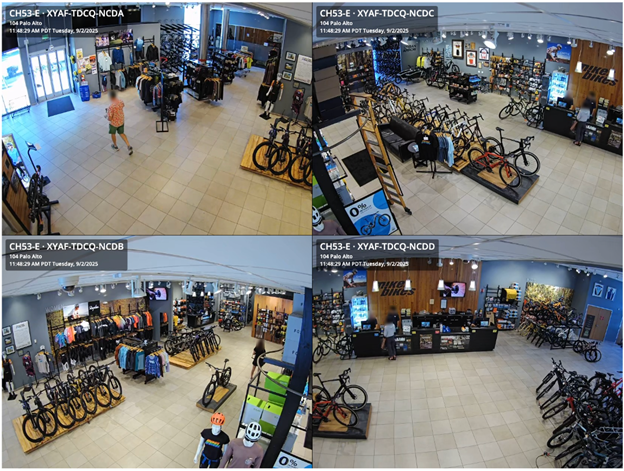The problem: blind spots, bandwidth, and ballooning costs
Securing large, complex sites has always forced a tradeoff: add more single-sensor cameras (and pay for extra cable runs, switch ports, VMS licenses), or accept blind spots and poor detail in critical areas. Hallway intersections, atriums, loading bays, and retail floors are especially tricky, wide fields of view demand more lenses, but every device you add increases network load and maintenance overhead.
Next-generation multisensor cameras change that equation. By combining multiple independently controlled camera heads into a single fixture and cable run, they deliver panoramic coverage, higher detail, and simpler deployments, all while improving analytics performance.
Crestron? Verkada? Axis? The bigger trend is the same: multisensors are becoming the backbone of modern video strategies. Below, we break down what the newest Verkada models bring to the table, and how to decide where they fit.
What’s new: redesigned four-head and two-head multisensors
Four-camera models (CH53-E, CH63-E)
- 360° coverage with wider per-lens viewing angles, ideal for intersections, corners, and open spaces.
- Improved night performance via refined IR distribution for more even low-light imagery.
- Simplified networking: now one MAC address and one IP per device, even with four heads.
- Faster installs: three-LED status indicator, easier PoE threading, and lens alignment presets reduce time on the ladder.
- Optional audio capture with a hardware mute switch plus a software toggle for policy control.
- Per-head independence: each lens supports optical zoom and analytics independently.
Two-camera models (CY63-E joins CY53-E)
- 4K per head option (CY63-E) for longer-range face/vehicle detail in corridors, entrances, and aisles.
- Same compact form factor as prior two-head units; each head retains independent zoom and analytics.
Resolution choices
- 5MP (CH53-E): excellent for broad situational awareness across large, open areas.
- 4K (CH63-E, CY63-E): higher detail and better distance performance for faces/plates, especially in busy or expansive spaces.
Why it matters: the pain points these models actually solve
1) Too many devices for the coverage you need
Pain: Covering a large lobby or warehouse aisle often takes several single-sensor cameras, more cable pulls, more switch ports, more licenses, more failure points.
Solution: A single multisensor delivers panoramic coverage from one mount and one cable run, dramatically reducing hardware and infrastructure overhead.
2) Gaps and “dead zones” at critical angles
Pain: Single lenses struggle with corners, intersections, and wrap-around views.
Solution: Four heads with wider FoV stitch together a true 360° view; each head can be aimed and zoomed to remove blind spots at doorways, stairwells, and intersections.
3) Low-light limitations hurt investigations
Pain: Nighttime footage often falls apart at the edges, uneven IR, blown highlights, muddy detail.
Solution: Enhanced IR distribution improves uniformity and clarity in low-light scenes, preserving investigative value after hours.
4) Network sprawl and management headaches
Pain: Managing dozens or hundreds of IPs and MACs slows IT, complicates NAC, and expands attack surfaces.
Solution: One IP/MAC per multisensor simplifies network access control, inventory, and ongoing administration, especially at scale.
5) Compliance and policy control around audio
Pain: Some sites need audio capture; others must disable it entirely.
Solution: An onboard mic with both physical mute and software toggle gives security leaders clear, auditable control aligned to policy.
Where they fit: practical deployment patterns
- Open retail floors & showrooms: One four-head unit near the center or at corners provides complete coverage without cluttering the ceiling (e.g., the CH53-E monitoring an entire sales floor from one port).
- Hallway intersections & building corners: Aim each head to cover every approach angle; use analytics per head to flag directional movement or loitering.
- Atriums & high-traffic lobbies: Choose 4K (CH63-E) for longer sight lines and higher detail at distance.
- Busy corridors & dual-direction chokepoints: Two-head 4K (CY63-E) excels at bi-directional monitoring, one head per direction for entrances/exits or warehouse aisles.
- Exterior perimeters: Wider IR and independent zoom let you cover approaches, gates, and corners with fewer devices and better night footage.
5MP vs 4K: a quick, real-world decision guide
- Choose 5MP when: your priority is wide situational awareness across open areas, and subjects remain relatively close.
- Choose 4K when you need longer-range detail for faces/vehicles, mixed lighting, or large, high-traffic spaces (atriums, transit nodes, major entrances).
- Mixed estates? Standardize on 4K for critical ingress/egress and 5MP for general awareness to balance cost and performance.
TCO and scalability: why multi-sensors are a smart upgrade path
- Fewer home runs: One cable run per four-head device reduces labor and materials.
- Fewer switch ports: Critical for dense deployments or PoE budget planning.
- Simpler IP hygiene: One IP/MAC per device eases NAC, DHCP planning, and inventory control.
- Faster installs & ops: Alignment presets and LED indicators get techs off lifts faster; fewer physical assets means fewer tickets later.
- Stronger analytics: Independent per-head processing (and higher pixel density in 4K models) improves detection quality without adding boxes.
Procurement snapshot (for planning teams)
- CH53-E (5MP, 4 heads) , single-cable, per-head zoom/analytics, redesigned IR & install.
- CH63-E (4K, 4 heads) , higher detail for larger spaces; same install and network simplifications.
- CY63-E (4K, 2 heads) , compact, bi-directional corridor/entry coverage with per-head control.
(CY53-E remains the 5MP two-head counterpart.)
How BCS helps you get it right the first time
Selecting the model is the easy part; designing coverage, bandwidth, storage, and analytics for your exact risk profile is where outcomes are won. BCS brings:
- Site-specific design: Lens aiming plans, FoV modeling, IR assumptions, retention math, and analytics mapping per zone.
- Network-ready deployments: PoE budgeting, VLAN/NAC planning, QoS, and IP addressing strategies aligned to your standards.
- Operationalization: Alert tuning, privacy/audio policy configuration, and workflows that reduce noise while elevating true events.
- Lifecycle support: Firmware governance, health monitoring, and expansion planning as your estate grows.
Next-gen multisensors let security teams cover more with less, less hardware, less cabling, fewer ports, and fewer blind spots, while delivering better low-light performance, stronger analytics, and simpler operations. Whether you’re upgrading a single lobby or standardizing across a multi-site portfolio, these cameras provide a scalable backbone for modern video strategy.
Planning a refresh or new build? BCS can model your coverage, specify the right mix of 5MP/4K heads, and deliver a deployment that’s defensible on both security and TCO. Let’s design a system that gives you complete coverage, without compromise.

